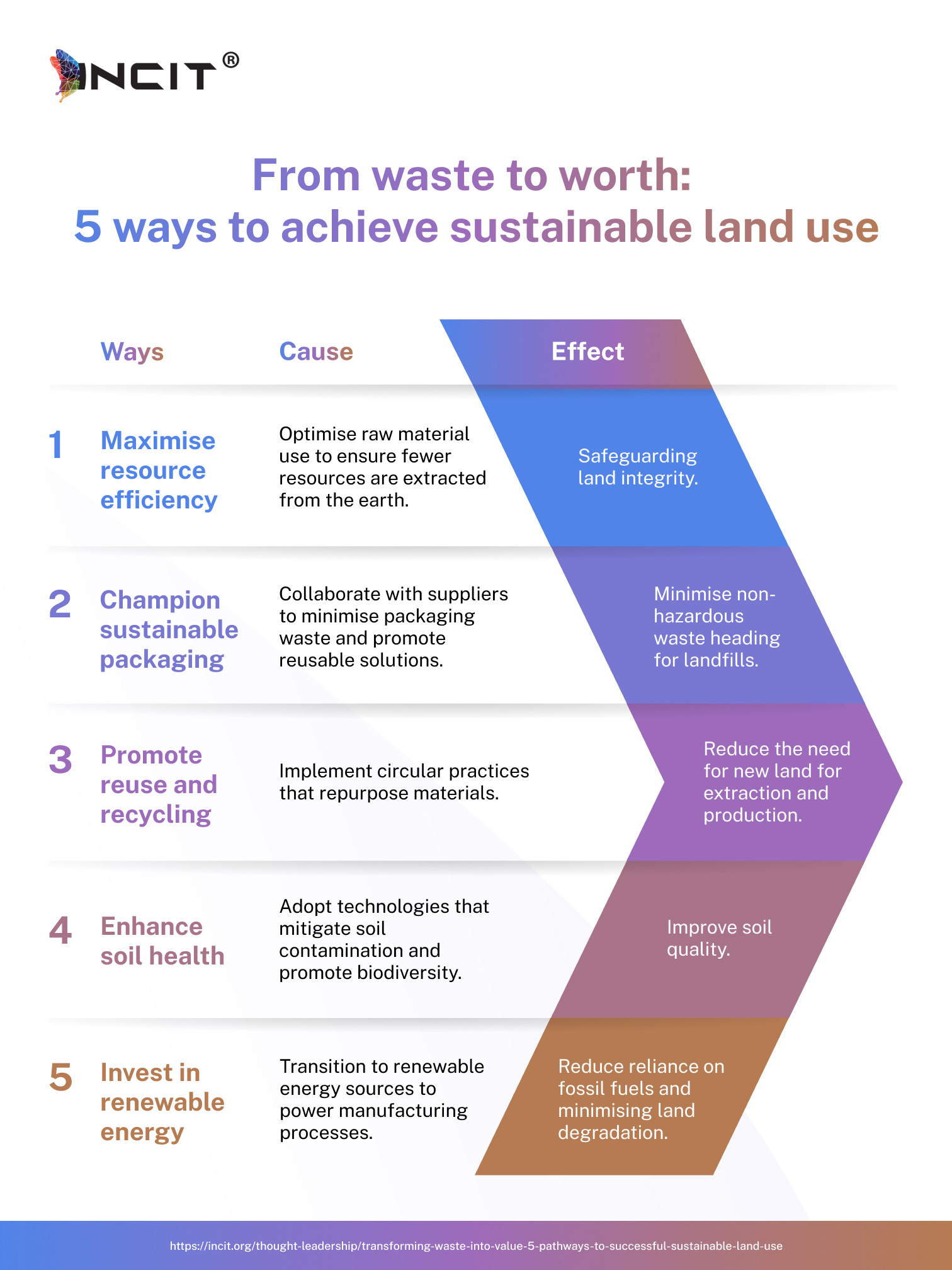Produkcja jest jednym z największych źródeł zanieczyszczeń na świecie i jest mało prawdopodobne, aby to się zmieniło, ponieważ popyt konsumentów na produkty nadal rośnie. Procesy przemysłowe, szczególnie w górnictwie i produkcji, historycznie były głównymi czynnikami przyczyniającymi się do zanieczyszczenia gleby, a wykorzystanie chemikaliów — z wyłączeniem farmaceutyków — ma wzrosnąć o 85 procent do 2030 roku. Jednak producenci nie mogą być bezczynni, jeśli chodzi o działania na rzecz klimatu. Muszą aktywnie uczestniczyć w ograniczaniu odpadów i promowaniu zrównoważonego użytkowania gruntów. Dzięki ograniczaniu odpadów społeczności są lepiej chronione i nie są negatywnie dotknięte przez przedsiębiorstwa, które przewodzą poprawie stanu środowiska w regionie dzięki działaniom, które zmniejszają zanieczyszczenie i chronią naturalne ekosystemy.
Jak producenci mogą odegrać wiodącą rolę? Po pierwsze, mogą zmniejszyć swój ślad ekologiczny i korzystać z ziemi w sposób zrównoważony, redukując ilość odpadów, zaczynając od recyklingu, kompostowania i odpowiedzialnej konsumpcji. Według McKinsey & Co. świat potrzebuje dodatkowych 70-80 milionów hektarów ziemi, aby zaspokoić potrzeby ludzkości w zakresie żywności i paliwa. Skąd będzie pochodzić ta nadająca się do zamieszkania ziemia? Chociaż jest to problem dla każdego, producenci muszą działać szybko, aby wkrótce stworzyć solidne podstawy dla zrównoważonego użytkowania ziemi i wyznaczyć punkt odniesienia dla innych sektorów.
Oto, w jaki sposób można wdrożyć ekologiczne techniki produkcyjne i uwzględnić zasady gospodarki o obiegu zamkniętym, takie jak minimalizacja odpadów, promowanie ponownego wykorzystania produktów i optymalizacja efektywnego gospodarowania zasobami w celu bardziej odpowiedzialnego zarządzania gruntami i ich regeneracji.

Aby skutecznie wdrożyć te praktyki, należy oprzeć się na Wskaźnik gotowości przemysłu na rzecz zrównoważonego rozwoju konsumentów (COSIRI), powszechnie uznawany framework do oceny dojrzałości zrównoważonego rozwoju w kluczowych obszarach, takich jak hala produkcyjna, łańcuch dostaw, logistyka, strategia i ryzyko. Zapewnia dyrektorom generalnym kluczowe spostrzeżenia dotyczące podejmowania strategicznych decyzji, promując zrównoważone praktyki w operacjach. Gotowy, aby wywrzeć znaczący wpływ na biznes? Dowiedz się więcej o tym, jak INCIT może działać jako Twój ekspercki przewodnik, wspierając Twoją organizację w kierunku bardziej zrównoważonych operacji, które skutkują ulepszonymi praktykami użytkowania gruntów poprzez kontakt z nami.
Często zadawane pytania dotyczące strategii zrównoważonego użytkowania gruntów w przemyśle
Czym jest zrównoważone użytkowanie gruntów w przemyśle?
Zrównoważone użytkowanie gruntów w przemyśle obejmuje planowanie i zarządzanie terenami przemysłowymi w celu zminimalizowania wpływu na środowisko, ograniczenia ilości odpadów i promowania długoterminowej efektywności wykorzystania zasobów, przy jednoczesnym wspieraniu wzrostu gospodarczego i dobrobytu społeczności.
W jaki sposób odpady mogą zostać przekształcone w wartość w użytkowaniu gruntów przemysłowych?
Odpady można przekształcić w wartość dodaną w użytkowaniu gruntów przemysłowych poprzez ponowne wykorzystanie materiałów, rekultywację terenów poprzemysłowych, wykorzystanie produktów ubocznych do produkcji energii lub budownictwa oraz uwzględnienie zasad gospodarki o obiegu zamkniętym w zagospodarowaniu terenu.
Jakie korzyści dla producentów wynikają ze zrównoważonego użytkowania gruntów?
Zrównoważone użytkowanie gruntów pomaga producentom ograniczać ryzyko środowiskowe, obniżać koszty operacyjne, lepiej spełniać standardy ESG, wzmacniać reputację marki i uzyskiwać nowe źródła dochodu dzięki innowacjom w zakresie przekształcania odpadów w wartość.
W jaki sposób planowanie zagospodarowania przestrzennego wspiera zrównoważony rozwój środowiska?
Planowanie użytkowania gruntów wspiera zrównoważony rozwój środowiska poprzez ograniczenie niszczenia siedlisk, efektywne zarządzanie zasobami, zapobieganie zanieczyszczeniu gleby i wody oraz umożliwianie ponownego wykorzystania istniejących terenów przemysłowych.
Jaka jest rola gospodarki o obiegu zamkniętym w zrównoważonym użytkowaniu gruntów?
Gospodarka o obiegu zamkniętym odgrywa kluczową rolę w zrównoważonym użytkowaniu gruntów poprzez promowanie ponownego wykorzystywania materiałów, minimalizowanie odpadów i wspieranie systemów zamkniętych, w których grunty, zasoby i infrastruktura są optymalizowane pod kątem długoterminowego użytkowania.
Jakie są przykłady strategii przekształcania odpadów w wartość w produkcji?
Przykładami mogą być: wykorzystywanie produktów ubocznych produkcji do wytwarzania energii, przetwarzanie odpadów przemysłowych na surowce do innych procesów oraz odzyskiwanie gruntów pod tereny zielone lub instalacje energii odnawialnej.
W jaki sposób tereny poprzemysłowe można przekształcić w miejsca o zrównoważonym przeznaczeniu?
Tereny poprzemysłowe można przekształcić poprzez remediację gleby, modernizację infrastruktury i wdrożenie zasad zrównoważonego projektowania. W ten sposób nieużywane lub zanieczyszczone grunty mogą zostać przekształcone w produktywne, przyjazne dla środowiska aktywa przemysłowe lub społeczne.
W jaki sposób zrównoważone użytkowanie gruntów przyczynia się do realizacji celów ESG?
Zrównoważone użytkowanie gruntów przyczynia się do realizacji celów ESG poprzez redukcję wpływu na środowisko (E), wspieranie lokalnych społeczności poprzez odpowiedzialny rozwój (S) i dostosowanie zarządzania gruntami do przejrzystych praktyk zarządzania (G).
Z jakimi wyzwaniami mierzą się firmy wdrażając strategie zrównoważonego użytkowania gruntów?
Do wyzwań należą wysokie koszty remediacji, złożoność przepisów, brak specjalistycznej wiedzy technicznej, opór interesariuszy oraz ograniczony dostęp do zrównoważonych materiałów lub opcji finansowania przebudowy terenu.


